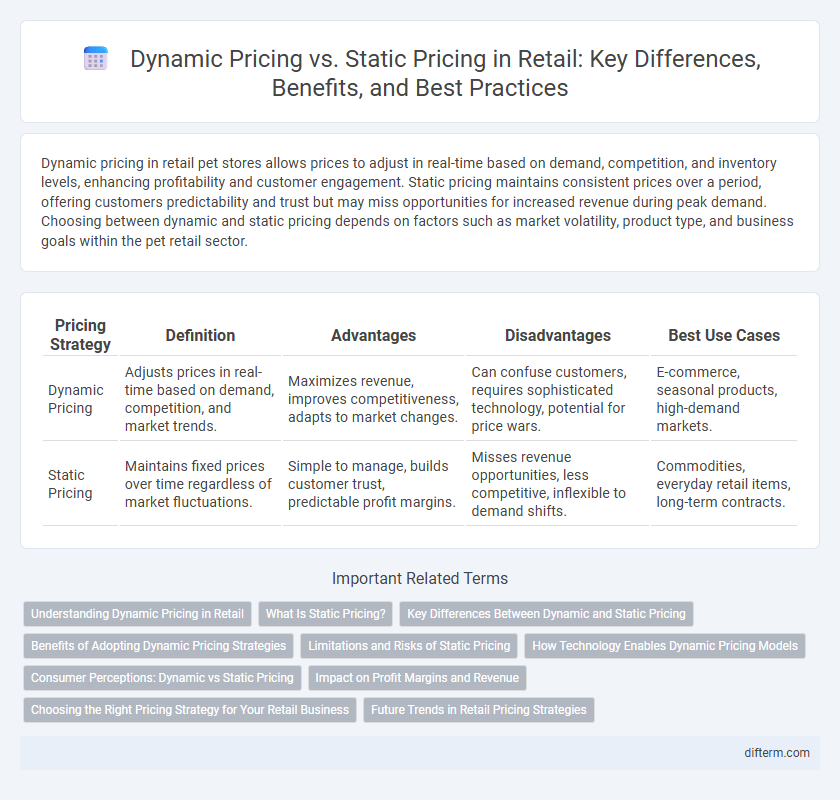Dynamic pricing in retail pet stores allows prices to adjust in real-time based on demand, competition, and inventory levels, enhancing profitability and customer engagement. Static pricing maintains consistent prices over a period, offering customers predictability and trust but may miss opportunities for increased revenue during peak demand. Choosing between dynamic and static pricing depends on factors such as market volatility, product type, and business goals within the pet retail sector.
Table of Comparison
| Pricing Strategy | Definition | Advantages | Disadvantages | Best Use Cases |
|---|---|---|---|---|
| Dynamic Pricing | Adjusts prices in real-time based on demand, competition, and market trends. | Maximizes revenue, improves competitiveness, adapts to market changes. | Can confuse customers, requires sophisticated technology, potential for price wars. | E-commerce, seasonal products, high-demand markets. |
| Static Pricing | Maintains fixed prices over time regardless of market fluctuations. | Simple to manage, builds customer trust, predictable profit margins. | Misses revenue opportunities, less competitive, inflexible to demand shifts. | Commodities, everyday retail items, long-term contracts. |
Understanding Dynamic Pricing in Retail
Dynamic pricing in retail involves adjusting prices in real-time based on factors such as demand, competition, inventory levels, and customer behavior to maximize revenue and market competitiveness. This strategy leverages advanced algorithms and data analytics to respond swiftly to market fluctuations, unlike static pricing which remains fixed over time regardless of external changes. Retailers using dynamic pricing can optimize profit margins, improve stock turnover, and enhance customer targeting through personalized pricing models.
What Is Static Pricing?
Static pricing refers to a fixed pricing strategy where product prices remain constant over time regardless of market demand, competition, or seasonality. Retailers using static pricing set prices based on cost, target margins, and perceived value without frequent adjustments. This approach simplifies pricing management but may limit responsiveness to market fluctuations and competitor actions.
Key Differences Between Dynamic and Static Pricing
Dynamic pricing adjusts product prices in real-time based on market demand, competitor pricing, and inventory levels, maximizing revenue and responsiveness. Static pricing maintains fixed prices over longer periods, providing price stability and predictability for customers but limiting flexibility. Retailers using dynamic pricing leverage data analytics and AI, while static pricing relies on predetermined strategies without frequent changes.
Benefits of Adopting Dynamic Pricing Strategies
Dynamic pricing enables retailers to optimize revenue by adjusting prices in real-time based on demand, competition, and inventory levels, leading to increased profitability. It allows for enhanced market responsiveness, ensuring products are competitively priced and reducing the risk of overstock or stockouts. Implementing dynamic pricing strategies improves customer segmentation and personalization, driving higher conversion rates and customer satisfaction in the retail sector.
Limitations and Risks of Static Pricing
Static pricing in retail often leads to missed revenue opportunities due to its inflexibility in responding to market demand fluctuations and competitor pricing changes. This approach risks inventory imbalances, either resulting in stockouts or excessive overstock, which increase holding costs or lost sales. Additionally, static pricing reduces the ability to personalize offers for diverse customer segments, limiting competitive differentiation and customer loyalty.
How Technology Enables Dynamic Pricing Models
Technology enables dynamic pricing models through real-time data analytics, artificial intelligence, and machine learning algorithms that assess market demand, competitor pricing, and customer behavior instantly. Retailers leverage cloud computing and big data platforms to process vast datasets, adjusting prices dynamically to maximize revenue and optimize inventory management. Automated pricing tools integrate seamlessly with e-commerce systems, ensuring rapid response to market fluctuations and personalized pricing strategies.
Consumer Perceptions: Dynamic vs Static Pricing
Dynamic pricing in retail often leads to perceptions of unfairness and unpredictability among consumers, as prices fluctuate based on demand, time, or customer profiles. Static pricing provides consistency and transparency, fostering trust by offering fixed prices that consumers can anticipate without sudden changes. Consumer preference frequently leans towards static pricing when valuing price stability and fairness, despite dynamic pricing's potential to maximize retailer revenue.
Impact on Profit Margins and Revenue
Dynamic pricing leverages real-time data and market demand fluctuations to optimize profit margins by adjusting prices based on customer behavior, inventory levels, and competitor actions, often resulting in increased revenue. Static pricing maintains fixed prices regardless of external factors, potentially limiting profit margins during high demand but offering pricing stability that can attract price-sensitive customers. Retailers employing dynamic pricing typically experience higher revenue growth due to enhanced responsiveness, while static pricing suits businesses prioritizing consistent margins and customer trust.
Choosing the Right Pricing Strategy for Your Retail Business
Selecting the right pricing strategy in retail involves evaluating dynamic pricing's ability to optimize revenue through real-time adjustments based on demand, competition, and inventory levels, compared to static pricing's consistency and simplicity that fosters customer trust and long-term loyalty. Retailers leveraging dynamic pricing often see increased profit margins by responding swiftly to market fluctuations, while static pricing suits businesses prioritizing stability and predictable profit margins. Understanding the target market, product type, and competitive landscape is crucial for tailoring a pricing approach that maximizes profitability and customer satisfaction.
Future Trends in Retail Pricing Strategies
Dynamic pricing leverages real-time data analytics, artificial intelligence, and machine learning to adjust prices based on demand fluctuations, competitor pricing, and inventory levels, making it a key future trend in retail. Static pricing, while simpler and more predictable, risks losing competitive edge and revenue optimization opportunities in an increasingly data-driven market. Retailers adopting dynamic pricing strategies are poised to enhance profitability, personalize customer experiences, and respond swiftly to market changes in the evolving retail landscape.
Dynamic Pricing vs Static Pricing Infographic

 difterm.com
difterm.com